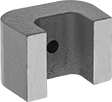About Magnets
More
Alnico Bridge Magnets


Alnico magnets aren't as strong as rare earth magnets, but they withstand the highest temperatures. Magnets come with a keeper that covers the poles to preserve the strength of the magnet and protect it from attracting metal during storage.
Warning: Maximum pull ratings are based on direct contact with rust-free and unpainted iron plate. Variations in material condition will significantly reduce these ratings. Do not use for lifting over people.
| Thick. | Hole Dia. | Wd. | Opening Wd. | Wd. at Poles | Lg. | Max. Pull, lbs. | Max. Temperature, °F | Magnet Grade | Each | |
| 3/4" | 3/16" | 1 1/8" | 9/16" | 1 1/16" | 3/4" | 13 | 970° | Alnico 5 | 0000000 | 000000 |
| 25/32" | 0.197" | 1.181" | 0.59" | 1 3/16" | 25/32" | 9 | 970° | Alnico 5 | 0000000 | 00000 |
| 63/64" | 0.197" | 1.575" | 0.787" | 1 37/64" | 63/64" | 19 | 970° | Alnico 5 | 0000000 | 00000 |
| 1" | 3/16" | 1 1/2" | 3/4" | 1 3/8" | 1" | 22 | 970° | Alnico 5 | 0000000 | 00000 |
| 1 1/8" | 3/16" | 1 3/4" | 7/8" | 1 1/2" | 1 1/8" | 30 | 970° | Alnico 5 | 0000000 | 00000 |
| 1.181" | 0.197" | 1.771" | 29/32" | 1 49/64" | 1.181" | 25 | 970° | Alnico 5 | 0000000 | 00000 |
| 1 7/8" | 1/4" | 2 1/2" | 1 3/8" | 2 1/2" | 1 13/16" | 70 | 970° | Alnico 5 | 0000000 | 000000 |
Alnico Horseshoe Magnets


Alnico magnets aren't as strong as rare earth magnets, but they withstand the highest temperatures. Magnets come with a keeper that covers the poles to preserve the strength of the magnet and protect it from attracting metal during storage.
Warning: Maximum pull ratings are based on direct contact with rust-free and unpainted iron plate. Variations in material condition will significantly reduce these ratings. Do not use for lifting over people.
| Thick. | Wd. | Opening Wd. | Wd. at Poles | Lg. | Max. Pull, lbs. | Max. Temperature, °F | Magnet Grade | Color | Each | |
| 1/4" | 1 7/64" | 13/32" | 47/64" | 1 1/8" | 6 | 970° | Alnico 5 | Red | 0000000 | 000000 |
| 19/64" | 1 1/8" | 1/4" | 29/32" | 1" | 2.2 | 970° | Alnico 5 | Red | 0000000 | 0000 |
| 19/64" | 1 1/8" | 1/4" | 29/32" | 1" | 5 | 970° | Alnico 5 | Red | 0000000 | 00000 |
| 7/16" | 1 1/2" | 3/8" | 1 1/4" | 1 1/4" | 9 | 970° | Alnico 5 | Gray | 0000000 | 00000 |
| 5/8" | 1 13/16" | 3/8" | 1 5/8" | 1 9/16" | 22 | 970° | Alnico 5 | Gray | 0000000 | 000000 |
| 3/4" | 3" | 1" | 2 1/2" | 2 1/2" | 60 | 970° | Alnico 5 | Red | 0000000 | 000000 |
| 1 1/4" | 5" | 1 1/2" | 4" | 4 1/8" | 210 | 970° | Alnico 5 | Red | 0000000 | 000000 |
Alnico U-Shape Magnets


Alnico magnets aren't as strong as rare earth magnets, but they withstand the highest temperatures. Magnets come with a keeper that covers the poles to preserve the strength of the magnet and protect it from attracting metal during storage.
Warning: Maximum pull ratings are based on direct contact with rust-free and unpainted iron plate. Variations in material condition will significantly reduce these ratings. Do not use for lifting over people.
| Hole Dia. | Wd. | Opening Wd. | Wd. at Poles | Lg. | Max. Pull, lbs. | Max. Temperature, °F | Magnet Grade | Each | |
15/16" Thick. | |||||||||
|---|---|---|---|---|---|---|---|---|---|
| 3/16" | 2 3/16" | 1 3/16" | 2 3/16" | 1 13/16" | 32 | 970° | Alnico 5 | 0000000 | 000000 |
| 1/4" | 2 7/16" | 1 3/16" | 2 7/16" | 2" | 35 | 970° | Alnico 5 | 0000000 | 00000 |
| 1/4" | 2 5/8" | 1 3/8" | 2 5/8" | 2 1/4" | 40 | 970° | Alnico 5 | 0000000 | 00000 |
| 1/4" | 3" | 1 1/2" | 3" | 2 1/2" | 50 | 970° | Alnico 5 | 0000000 | 00000 |
1" Thick. | |||||||||
| 3/16" | 3" | 1 3/4" | 3" | 1 11/16" | 55 | 970° | Alnico 5 | 0000000 | 00000 |

























